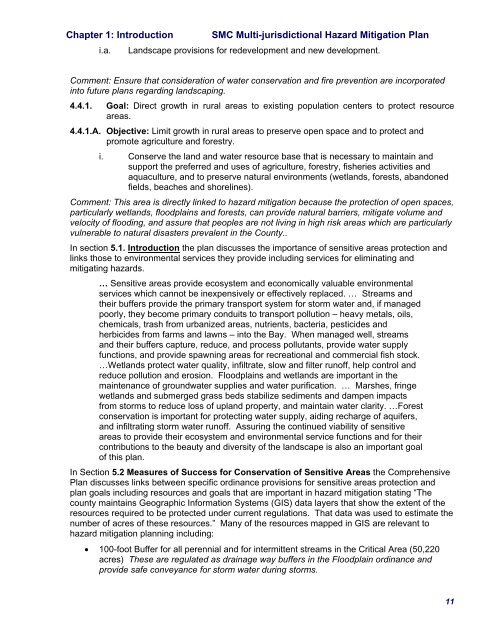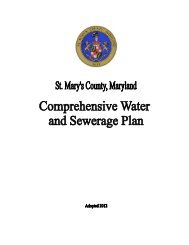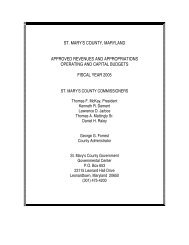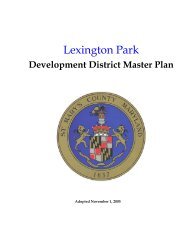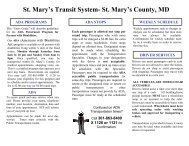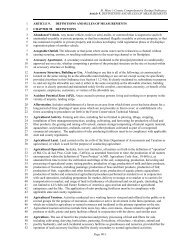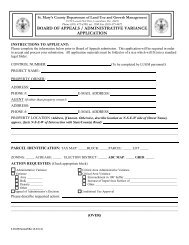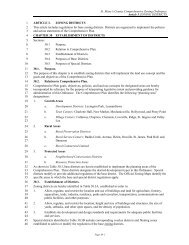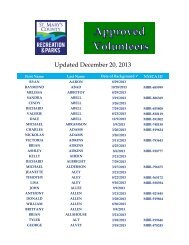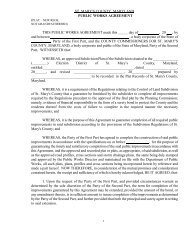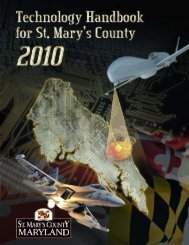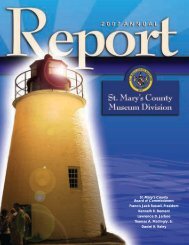St. Mary's County Multi-Jurisdictional Hazard Mitigation Plan
St. Mary's County Multi-Jurisdictional Hazard Mitigation Plan
St. Mary's County Multi-Jurisdictional Hazard Mitigation Plan
Create successful ePaper yourself
Turn your PDF publications into a flip-book with our unique Google optimized e-Paper software.
Chapter 1: Introduction SMC <strong>Multi</strong>-jurisdictional <strong>Hazard</strong> <strong>Mitigation</strong> <strong>Plan</strong><br />
i.a. Landscape provisions for redevelopment and new development.<br />
Comment: Ensure that consideration of water conservation and fire prevention are incorporated<br />
into future plans regarding landscaping.<br />
4.4.1. Goal: Direct growth in rural areas to existing population centers to protect resource<br />
areas.<br />
4.4.1.A. Objective: Limit growth in rural areas to preserve open space and to protect and<br />
promote agriculture and forestry.<br />
i. Conserve the land and water resource base that is necessary to maintain and<br />
support the preferred and uses of agriculture, forestry, fisheries activities and<br />
aquaculture, and to preserve natural environments (wetlands, forests, abandoned<br />
fields, beaches and shorelines).<br />
Comment: This area is directly linked to hazard mitigation because the protection of open spaces,<br />
particularly wetlands, floodplains and forests, can provide natural barriers, mitigate volume and<br />
velocity of flooding, and assure that peoples are not living in high risk areas which are particularly<br />
vulnerable to natural disasters prevalent in the <strong>County</strong>..<br />
In section 5.1. Introduction the plan discusses the importance of sensitive areas protection and<br />
links those to environmental services they provide including services for eliminating and<br />
mitigating hazards.<br />
… Sensitive areas provide ecosystem and economically valuable environmental<br />
services which cannot be inexpensively or effectively replaced. … <strong>St</strong>reams and<br />
their buffers provide the primary transport system for storm water and, if managed<br />
poorly, they become primary conduits to transport pollution – heavy metals, oils,<br />
chemicals, trash from urbanized areas, nutrients, bacteria, pesticides and<br />
herbicides from farms and lawns – into the Bay. When managed well, streams<br />
and their buffers capture, reduce, and process pollutants, provide water supply<br />
functions, and provide spawning areas for recreational and commercial fish stock.<br />
…Wetlands protect water quality, infiltrate, slow and filter runoff, help control and<br />
reduce pollution and erosion. Floodplains and wetlands are important in the<br />
maintenance of groundwater supplies and water purification. … Marshes, fringe<br />
wetlands and submerged grass beds stabilize sediments and dampen impacts<br />
from storms to reduce loss of upland property, and maintain water clarity. …Forest<br />
conservation is important for protecting water supply, aiding recharge of aquifers,<br />
and infiltrating storm water runoff. Assuring the continued viability of sensitive<br />
areas to provide their ecosystem and environmental service functions and for their<br />
contributions to the beauty and diversity of the landscape is also an important goal<br />
of this plan.<br />
In Section 5.2 Measures of Success for Conservation of Sensitive Areas the Comprehensive<br />
<strong>Plan</strong> discusses links between specific ordinance provisions for sensitive areas protection and<br />
plan goals including resources and goals that are important in hazard mitigation stating “The<br />
county maintains Geographic Information Systems (GIS) data layers that show the extent of the<br />
resources required to be protected under current regulations. That data was used to estimate the<br />
number of acres of these resources.” Many of the resources mapped in GIS are relevant to<br />
hazard mitigation planning including:<br />
• 100-foot Buffer for all perennial and for intermittent streams in the Critical Area (50,220<br />
acres) These are regulated as drainage way buffers in the Floodplain ordinance and<br />
provide safe conveyance for storm water during storms.<br />
11


